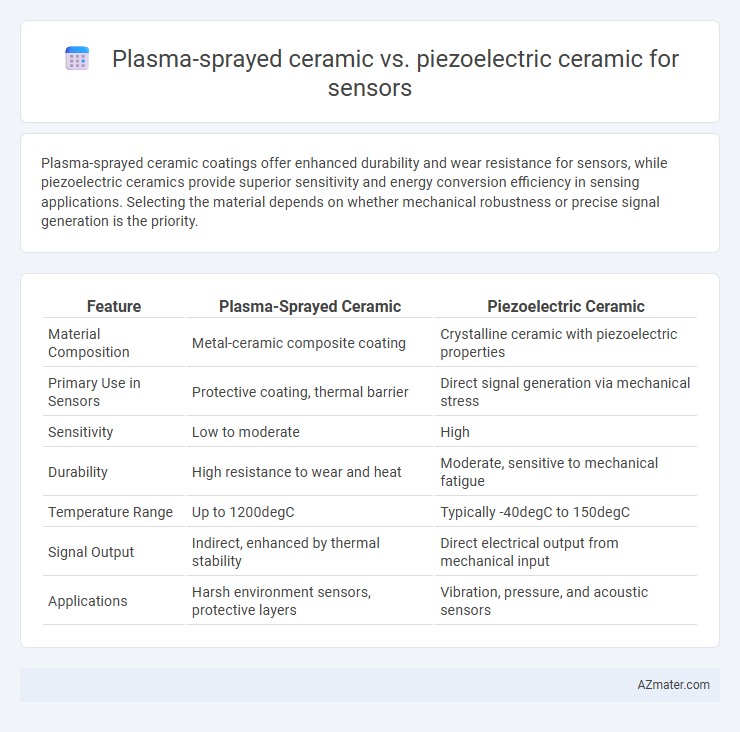Plasma-sprayed ceramic coatings offer enhanced durability and wear resistance for sensors, while piezoelectric ceramics provide superior sensitivity and energy conversion efficiency in sensing applications. Selecting the material depends on whether mechanical robustness or precise signal generation is the priority.
Table of Comparison
| Feature | Plasma-Sprayed Ceramic | Piezoelectric Ceramic |
|---|---|---|
| Material Composition | Metal-ceramic composite coating | Crystalline ceramic with piezoelectric properties |
| Primary Use in Sensors | Protective coating, thermal barrier | Direct signal generation via mechanical stress |
| Sensitivity | Low to moderate | High |
| Durability | High resistance to wear and heat | Moderate, sensitive to mechanical fatigue |
| Temperature Range | Up to 1200degC | Typically -40degC to 150degC |
| Signal Output | Indirect, enhanced by thermal stability | Direct electrical output from mechanical input |
| Applications | Harsh environment sensors, protective layers | Vibration, pressure, and acoustic sensors |
Introduction to Ceramic Materials in Sensor Technology
Plasma-sprayed ceramic coatings provide enhanced mechanical strength and thermal stability crucial for sensor applications exposed to harsh environments, offering superior wear resistance and insulation properties. Piezoelectric ceramics, such as lead zirconate titanate (PZT), enable precise conversion of mechanical stress into electrical signals, making them essential for dynamic sensing and energy harvesting. These ceramic materials differ in their functional roles: plasma-sprayed ceramics primarily serve as protective or insulating layers, while piezoelectric ceramics act as the active sensing elements in various sensor technologies.
Overview of Plasma-Sprayed Ceramic Sensors
Plasma-sprayed ceramic sensors offer enhanced durability and thermal stability, making them ideal for harsh environments where conventional piezoelectric ceramics may degrade. The plasma spraying process creates a porous, adherent ceramic coating that improves sensitivity and response time by facilitating efficient stress transfer. These sensors excel in high-temperature applications such as combustion monitoring and industrial process control, outperforming traditional piezoelectric ceramics in mechanical robustness and operational lifespan.
Fundamentals of Piezoelectric Ceramic Sensors
Piezoelectric ceramic sensors operate based on the direct piezoelectric effect, where mechanical stress generates an electric charge, enabling precise detection of pressure, vibration, and acceleration. Plasma-sprayed ceramic coatings primarily enhance surface properties but lack the intrinsic piezoelectric response necessary for sensing applications. Fundamental materials such as lead zirconate titanate (PZT) exhibit high piezoelectric coefficients, making them ideal for sensors requiring high sensitivity and stability.
Material Properties: Plasma-Sprayed vs Piezoelectric Ceramics
Plasma-sprayed ceramics exhibit high thermal stability, excellent wear resistance, and robust mechanical strength due to their dense and adherent coating structure, making them suitable for harsh environments. Piezoelectric ceramics, such as PZT, offer superior electromechanical coupling, high sensitivity, and precise strain response necessary for accurate sensor applications. While plasma-sprayed ceramics provide enhanced durability and thermal insulation, piezoelectric ceramics excel in transduction efficiency and signal generation within sensor devices.
Fabrication and Processing Techniques
Plasma-sprayed ceramic sensors benefit from high-temperature thermal spraying techniques that create dense, adherent ceramic coatings with controlled microstructures, enhancing durability and wear resistance. Piezoelectric ceramic sensors are typically fabricated using solid-state sintering or tape casting followed by poling processes to align dipoles, enabling efficient electromechanical energy conversion. The fabrication of plasma-sprayed ceramics allows rapid deposition on complex geometries, whereas piezoelectric ceramics require precise powder processing and sintering parameters to achieve optimal piezoelectric properties.
Performance Comparison in Sensing Applications
Plasma-sprayed ceramic coatings exhibit enhanced mechanical robustness and thermal stability, making them suitable for harsh sensing environments, while piezoelectric ceramics deliver superior sensitivity and signal accuracy due to their intrinsic electromechanical coupling properties. In sensing applications, plasma-sprayed ceramics demonstrate greater durability and resistance to wear, but piezoelectric ceramics outperform in dynamic response and precision measurement. The performance trade-off depends on the specific application requirements, with plasma-sprayed ceramics favored for high-temperature and abrasive conditions and piezoelectric ceramics preferred for high-resolution sensing.
Durability and Environmental Resistance
Plasma-sprayed ceramic coatings exhibit superior durability and enhanced environmental resistance compared to piezoelectric ceramics, making them ideal for harsh operating conditions and prolonged sensor lifespan. These coatings provide excellent wear resistance, high-temperature tolerance, and protection against corrosion and moisture, ensuring stable sensor performance in extreme environments. While piezoelectric ceramics offer high sensitivity and precise signal generation, they are generally more susceptible to mechanical fatigue and environmental degradation over time.
Cost Efficiency and Scalability
Plasma-sprayed ceramic coatings offer superior scalability and cost efficiency for sensor applications due to lower material waste and faster production rates compared to piezoelectric ceramics. Piezoelectric ceramics, while providing high sensitivity, require complex fabrication and poising processes, increasing overall costs and limiting mass production. Choosing plasma-sprayed ceramics can reduce sensor manufacturing expenses and enable large-scale deployment without compromising durability.
Application Suitability: Industrial and Medical Sensors
Plasma-sprayed ceramic coatings exhibit excellent wear resistance and thermal stability, making them suitable for harsh industrial sensor environments requiring durability and high-temperature operation. Piezoelectric ceramics offer superior sensitivity and precise signal detection, ideal for medical sensors needing accurate physiological monitoring and real-time data acquisition. Industrial sensors benefit from plasma-sprayed ceramics' robustness, while medical sensors rely on piezoelectric ceramics for their electromechanical coupling efficiency.
Future Trends and Innovations in Ceramic Sensor Materials
Plasma-sprayed ceramics offer enhanced surface adhesion and thermal stability, making them suitable for high-temperature sensor applications, while piezoelectric ceramics provide superior sensitivity and responsiveness for precise mechanical and acoustic sensing. Emerging innovations focus on developing nanostructured ceramic composites and multifunctional coatings to improve durability, signal accuracy, and integration with flexible electronics. Future trends emphasize eco-friendly synthesis methods and smart sensor designs that leverage AI-driven data analytics for real-time monitoring in healthcare, aerospace, and industrial automation.

Infographic: Plasma-sprayed ceramic vs Piezoelectric ceramic for Sensor
 azmater.com
azmater.com